- en
Your cat is constipated and feeling uncomfortable!
This information prescription will help you know what to do, how to make your cat more comfortable, and how to prevent this from happening in the future.
Quick Links
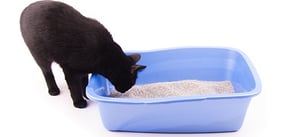
Our mission is to help save dogs' and cats’ lives through our educational content. To support our efforts, this page may contain affiliate links. We earn a commission for qualifying purchases – at no cost to you.
Constipation is a cat’s inability to easily and routinely empty their bowels. Normally the colon, or lower part of the gastrointestinal tract, acts as a reservoir for digested food, mucus, and bacteria. The main function of the colon is to absorb water from the feces. The longer the feces is retained in the colon, the drier and harder it becomes. Therefore, passing it becomes difficult. Constipated cats strain trying to get the feces to move.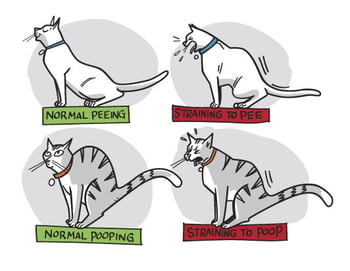
The inset illustration shows normal and straining positions for cats urinating and defecating.
While cats of any age can suffer from constipation, it is most common in mature middle-aged cats. Signs of constipation can include small, firm fecal matter, straining or crying in the litter box, infrequent defecation, or blood on the feces. Some cats will pass a liquid poop due to straining. This is often confused for diarrhea by many owners.
Megacolon occurs when the colon is dilated and weak. While it can be the cause of constipation, it can also be the result of it. Cats that suffer from long-term or regular repeated bouts of constipation can develop megacolon.
Normally, cats will poop at least once every 24 to 36 hours. If, however, your cat goes more than 48 to 72 hours without pooping, it is time to consult a veterinarian. Additionally, if you notice your cat crying and straining, you need to contact a veterinarian immediately.
Cats typically have a bowel movement 1 to 3 times each day, and constipation could be the cause if there is no bowel movement in 2 to 3 days. This condition isn’t uncommon in cats and can be due to low water consumption, an injury, medication side effects, intestinal tumors, metabolic disease, advanced neurologic conditions, hairballs (especially longhaired cats), and obesity/lack of exercise.
Typically, dehydrated cats are prone to becoming constipated because the stool dries out and can no longer move through their colon with ease. Diseases and conditions like chronic kidney disease, inflammatory bowel disease, obesity, megacolon, etc., can cause dehydration and alter intestinal motility, and therefore hinder proper removal of feces. Dried stool then clumps together and can completely block further movement.
Indirectly, stress can cause cats to become constipated. If your cat is hiding because they are distressed, they are likely not drinking enough or venturing out to use their litter box. Some cats also become stressed if their litter box is not always clean and will avoid using a litter box which can lead to constipation. Lastly, the stress cats feel when painful from arthritis can prevent them from using the litter box regularly, and unfortunately, this can lead to constipation.
Constipated cats need medical attention from a veterinarian. Effective treatment usually involves identification and treatment of the cause of the issue and removal of impacted feces. Your veterinarian may suggest running tests like bloodwork and x-rays in order to diagnose constipation accurately. Treatment of a constipated cat most commonly involves administering an enema to loosen the impacted feces and sometimes even requires manual removal of it. This should not be attempted at home as some over-the-counter enemas are toxic to pets, and sometimes cats require sedation for this procedure. After removing the impacted fecal matter, your vet may recommend fluids to rehydrate your cat, medications, and a special diet to prevent it from happening again.
The best thing you can do is to administer medications and/or a prescription diet as directed and monitor your cat’s defecation habits.
Placing a calming pheromone diffuser in your cat’s main area can help soothe them after their unpleasant event and hopefully help control stress to prevent re-occurrence. If your cat’s veterinarian approves, there are calming treats that can be used as well.
Adding additional litter boxes around your home will allow your cat to rest more instead of seeking out their litter box. Cats love to have a choice in which box they use.
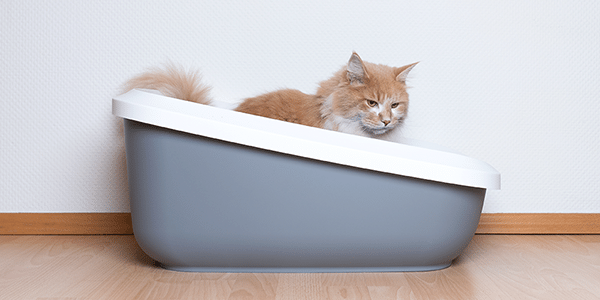
After visiting your vet, you should notice that your cat is producing normal, moist stool and is no longer uncomfortable when going in their litter box.
If your cat is straining to defecate or has not produced fecal matter within 2 days, you should consult your veterinarian. If you notice a change in the consistency, color, or presence of blood in the stool, you should reach out to your vet right away.

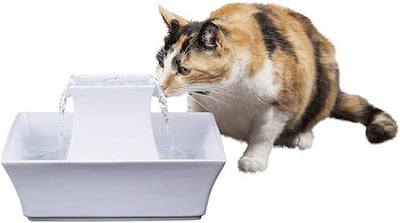 Sometimes constipation cannot be prevented, but the best thing you can do at home is to provide access to fresh water at all times to avoid dehydration. Many cats love water fountains, so it's worth trying for your cat.
Sometimes constipation cannot be prevented, but the best thing you can do at home is to provide access to fresh water at all times to avoid dehydration. Many cats love water fountains, so it's worth trying for your cat.
Some cats will drink more frequently if flavoring, such as low sodium chicken broth (no onions or garlic) or tuna juice (be sure the tuna was packed in water), is added to their water bowl. For some cats, changing the water several times per day increases their consumption as well.
If your cat is overweight or is generally inactive, speak with your cat’s veterinarian about how to help them lose weight and increase activity. If arthritis is affecting your cat’s mobility, your veterinarian can help you manage your cat’s discomfort so they will be more mobile.
Add additional oversized litter boxes that are easy to enter and exit. Hopefully, this will make using the litter box easier and ensure that there is always a clean box to be found. Some people find that automatic-cleaning litter boxes are beneficial for cats that refuse to use a slightly soiled box.
Work on ways to minimize any stress to your cat. This can include allowing your cat to have needed ‘alone’ time away from other pets. Using pheromones (diffusers or sprays) and supplements can help. Also, consult with your veterinarian about using pre- and probiotics with your cat to help maintain optimal gut health.
Lastly, you should always follow diet and medication recommendations from your veterinarian to keep your feline friend's digestive system happy and healthy!
The Pet InfoRx® is made possible, in part, through our partnership with AlignCare®.
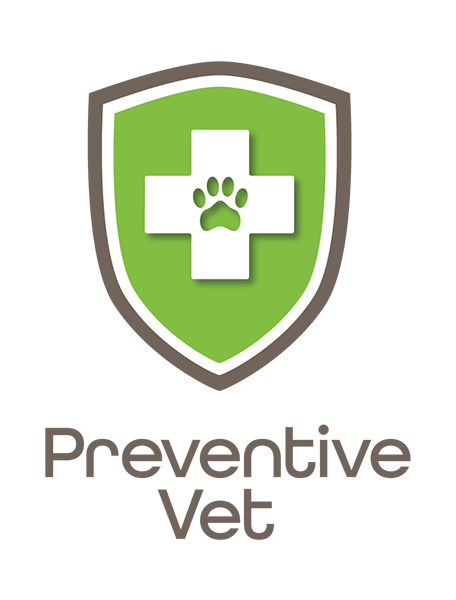

© Preventive Vet. All rights reserved. PreventiveVet.com
